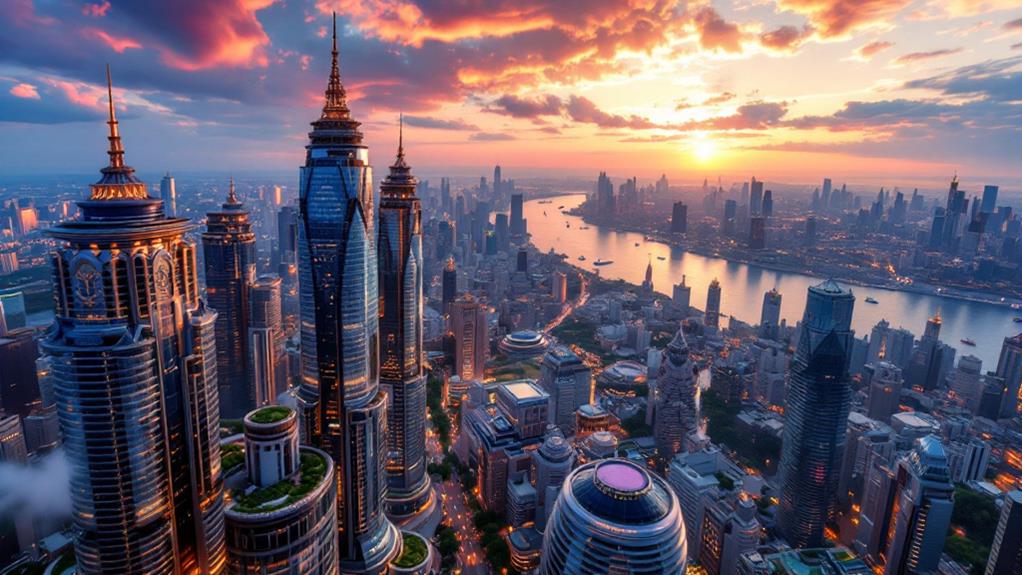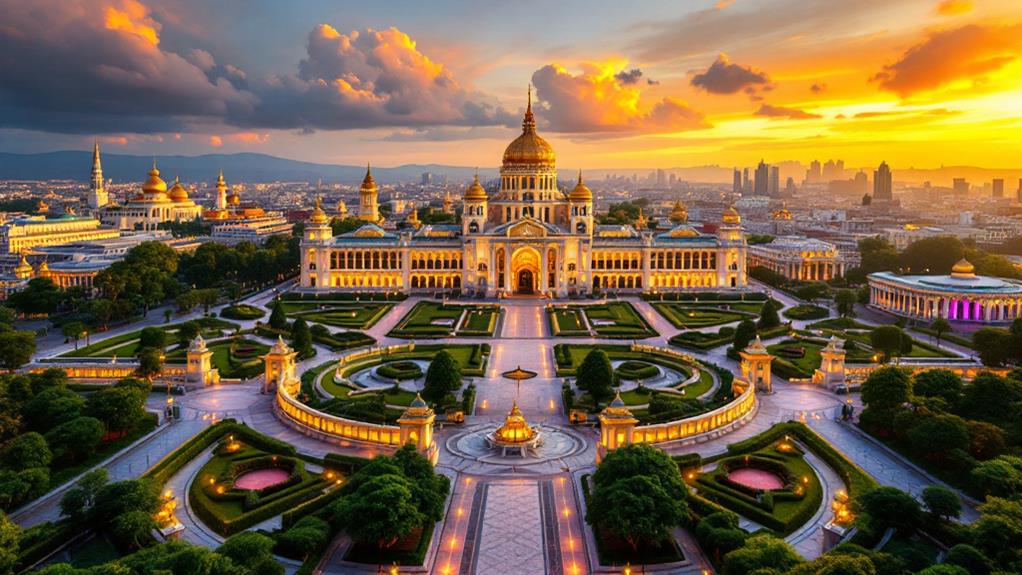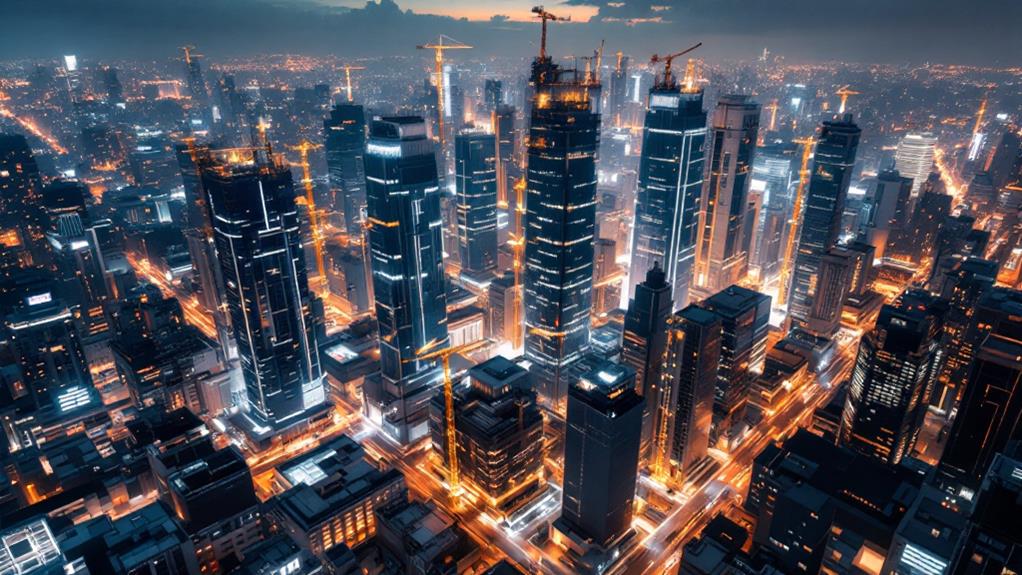The Most Expensive Largest Buildings Ever Constructed

You're stepping into the world of architectural wonders with some of the most expensive and largest buildings ever constructed. The Great Mosque of Mecca, dominating the list, cost an astounding $100 billion, making it the most expensive. Abraj Al Bait in Mecca, with the largest clock face, cost $15 billion. The iconic Marina Bay Sands in Singapore comes in at $8 billion. Standing tall, the Burj Khalifa cost $1.5 billion and is the world's tallest building. Each of these marvels showcases incredible engineering and cultural significance, and there's even more fascinating information just waiting for you.
Architectural Marvels
When you think of architectural marvels, it's impossible not to be awed by the sheer magnitude and ingenuity of the world's largest buildings. The Great Mosque of Mecca, also known as Masjid al-Haram, stands as the world's largest mosque and is the most expensive building ever constructed, with a staggering construction cost of $100 billion. Its continuous expansions reflect its historical and spiritual significance. Nearby, the Abraj Al Bait towers over Mecca, with the world's largest clock face. This $15 billion complex blends modern architecture with the sacred site's rich history, offering luxury hotel accommodations right beside the holy mosque.
Traveling to Singapore, the Marina Bay Sands represents an iconic blend of luxury and innovation. Completed in 2010 at $8 billion, it boasts a unique sky park and infinity pool, drawing tourists worldwide. Meanwhile, the Burj Khalifa in Dubai, celebrated as the tallest building globally at 828 meters, cost $1.5 billion to construct. It offers a luxurious experience with 163 floors and an observation deck on the 148th floor, providing panoramic views. Each of these structures not only exemplifies architectural brilliance but also highlights the vast resources invested in creating such monumental feats.
Iconic Skyscrapers
Have you ever wondered what defines the skyline of a modern city? It's the iconic skyscrapers that dominate, each a marvel of engineering and ambition. The Burj Khalifa in Dubai tops the list as the tallest building globally, reaching an astounding 828 meters. With a construction cost of $1.5 billion, it's a demonstration of Dubai's architectural prowess. Next up is the Shanghai Tower, the second tallest building, standing at 632 meters. This spiraling structure had a construction cost of $2.4 billion, making it a standout feature in Shanghai's skyline.
Consider Taipei 101, which held the title of the tallest building until the Burj Khalifa was completed. It towers at 508 meters and showcases creative green building features. With a construction cost of $1.8 billion, it's an iconic landmark in Taiwan.
Here are some key highlights:
- Princess Tower: Dubai's residential icon, 414 meters tall, cost $2.17 billion.
- One World Trade Center: In New York, symbolizes resilience, nearly 514 meters, $4 billion.
- Taipei 101: Green innovation, 508 meters, $1.8 billion.
These skyscrapers are more than just buildings; they're symbols of human accomplishment.
Cultural Landmarks

While skyscrapers define modern skylines, cultural landmarks embody the soul and history of a place. Take the Great Mosque of Mecca, the world's largest mosque and a symbol of spiritual significance. With an astounding construction cost of around $100 billion, it stands as the most expensive building ever constructed. Nearby in Mecca, you'll find the Abraj Al Bait complex. Costing approximately $15 billion, it houses the world's largest clock face, making it a notable cultural landmark adjacent to the sacred Kaaba.
Then there's the Louvre Abu Dhabi, a masterpiece of architectural ambition. With its unique dome design and an estimated cost of $1.3 billion, it showcases a remarkable collection of art and historical artifacts. The Palace of the Parliament in Bucharest is another example of grandiose vision. As the world's second-largest administrative building, it cost about $3 billion and reflects the cultural significance of its time.
Innovative Engineering
Incorporating cutting-edge technology, the domain of groundbreaking engineering stretches the boundaries of what's possible in construction and design. The Great Mosque of Mecca, with its staggering construction cost of $100 billion, is a demonstration of advanced engineering techniques. It accommodates over 1.2 million worshippers, showcasing inventive design in large-scale religious architecture.
Consider these marvels of inventive engineering:
- Burj Khalifa: At 828 meters, this skyscraper uses a bundled tube structural system, providing stability against wind forces. It stands as a symbol of modern engineering prowess.
- Shanghai Tower: Completed in 2015 for $2.4 billion, it features a twisting design that reduces wind loads on the building. This skyscraper construction showcases the inventive solutions engineers employ to reach new heights.
- International Space Station: With a hefty $150 billion price tag, its modular design allows for continuous upgrades and international collaboration. It's a shining example of advanced engineering beyond Earth.
Lastly, the Abraj Al Bait in Mecca, costing $15 billion, includes the world's largest clock face. It employs cutting-edge construction technology, ensuring both structural integrity and aesthetic appeal amid historical surroundings.
Economic Impacts

Megaprojects don't just redefine skylines; they also reshape economies. When you witness the construction of a $100 billion project like the Great Mosque of Mecca, it's clear that such developments greatly enhance local economies. The influx of millions of visitors annually turns these sites into tourism goldmines, with hospitality sectors thriving due to the increased demand for services.
Investments in large-scale projects, such as the $15 billion Abraj Al Bait complex, ripple through the economy. During construction, they create jobs, and once operational, they continue to employ thousands in hospitality and services. This economic activity doesn't stop at the project site; it extends into surrounding areas, improving the general economic dynamism.
Consider Marina Bay Sands, a $5.5 billion marvel that transformed Singapore into a must-visit destination, showcasing how expensive buildings can raise a city's global profile. Megaprojects also drive innovations in construction and architectural practices, as seen with the Burj Khalifa's $1.5 billion investment. Technological advancements lead to more efficient building methods, further stimulating economic growth. In Mumbai, the $2 billion Antilia has had a multiplier effect, spurring further development and infrastructure improvements.



